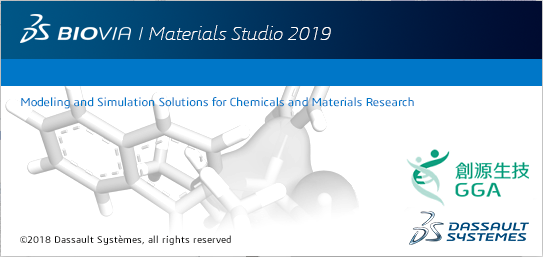What's new in Materials Studio 2019
What's new in Materials Studio 2019
A new module, Kinetix, has been made available. Kinetix provides predictions for the spacial distribution of reactants and products on reactive surfaces, such as catalyst surfaces, as a function of time using a Kinetic Monte Carlo approach.
MATERIALS STUDIO 2019 HIGHLIGHTS
New feature! Sensitivity analysis has been added to Cantera CSTR task. This feature allows user to determine the most important steps in the reaction chain and potentially save time on simulations of complex multi-step reaction mechanisms by excluding less important reactions from needing to be considered. It is equally important to know which reactions merit more accurate calculations of thermodynamics and reaction barriers.
New feature! A new task for simulation of Temperature Programmed Desorption has been introduced in the Cantera module.
New script! A script has been developed to import third-party reaction mechanisms into Materials Studio to be used with Cantera.
Enhancements to Materials Studio modules
CASTEP
- Finite displacement calculations of vibrational properties with CASTEP can be now performed using the “interpolation” option. This scheme uses non-diagonal supercells as developed by Lloyd-Williams and Monserrat and is more efficient than the previously available approach.
- CASTEP calculations of chemical shifts are now possible for highly correlated systems where the use of DFT+U approach is required (for example, transition metal oxides or systems containing f-elements).
- The many-body dispersion (MBD) correction scheme by Ambrosetti et al. (2014) has been implemented in CASTEP and offers a more accurate description of weakly bonded systems than other existing approaches. The MBD scheme supports full geometry optimization and property calculations.
- CASTEP output now reports the result of the check for “ghost states” that might be associated with the given pseudopotentials. If such states are found, results of optical properties calculations and band structure or DOS calculations of the conduction band will have spurious features. A number of settings for on the fly generation of pseudopotentials have been modified to eliminate ghost states.
DFTB+
- A script for merging DFTB+ parameter files has been added to the DFTB+ Parameterization Tool Set available in the BIOVIA Materials Studio Community.
DMol3
- The SCAN meta-GGA functional has been added to DMol3.
- A checkbox has been added to the geometry optimization and TS optimization dialogs in DMol3 to enable the use of Cartesian coordinates for optimization.
- DMol3 reporting of exchange-correlation functionals in the outmol file has been simplified and made more user friendly and reporting of the progress of a DMol3 Geometry Optimization or Transition State Optimization has been improved to explain why the process might continue even though the force and energy criteria are satisfied.
- Numerically stable Kohn-Sham eigenvalue solver has been added to enable solution of extremely rare systems where DMol3 detects a singular overlap matrix.
-ONETEP
- The ability to set global NGWFs radii for all elements has been added to the -ONETEP interface.
GULP
- The latest version of GULP code, 5.1, has been incorporated in Materials Studio.
- New modified embedded atom model parameters for MEAM2NN library to extend the range of accessible systems and MEAM-2NN-QEq, for modeling of Li-Mn-O materials relevant for simulations of batteries
- Split bond charge electronegativity equalization method (EEM) added.
- Third party package Alamode, that allows calculation of thermal conductivity via the Boltzmann transport equations, can be connected GULP server.
- Grüneisen parameters, phonon group velocities, mean squared displacements for phonon thermal parameters, eigenvalues of elastic constants for elastic stability check.
- New potential forms added: Slater potential and buffered 14-7 Lennard-Jones potential.
- Fitting of free energy and of absolute dipole moment.
- Vibrational frequencies for molecules and (at Gamma point) for solids have been made available for ReaxFF and MEAM families of libraries.
Forcite
- Forcite geometry optimization has been extended to allow for the optimization of a charged system which is subject to an electric field.
Forcefield
- The forcefield document, and Forcite and Mesocite, now support the tabulated form for torsion interactions.
Enhancements to Materials Visualizer
- File compression is now used by default for AVI movie export of trajectory animations from Materials Studio. This results in a typical file size reduction by a factor of ten. It is also observed that there are fewer playback problems with compressed AVI video than there had been for uncompressed AVI video.
- You can now browse a job folder of a running Pipeline Pilot protocol through a web browser, this is analogous to browsing gateway jobs.
- A new algorithm has been implemented for constructing Reaction Previews for 3D periodic systems.
- The Pipeline Pilot Connector will now allow you to access some parameters from a protocol’s Implementation tab. This means that you can now use the Pipeline Pilot Connector to submit an entire protocol to a queuing system.


